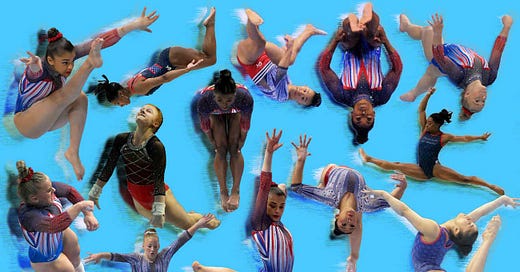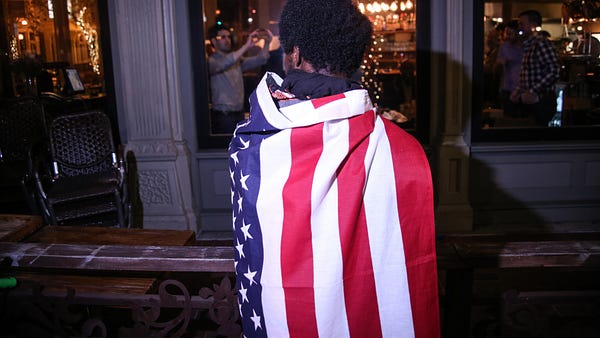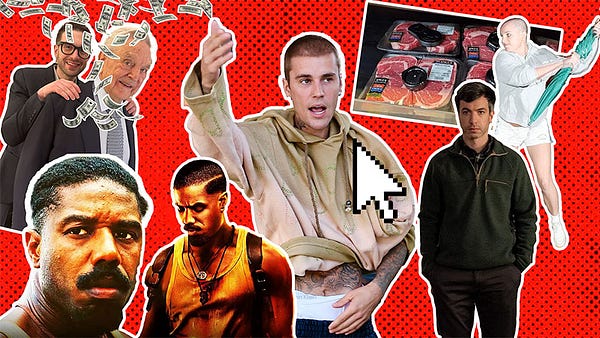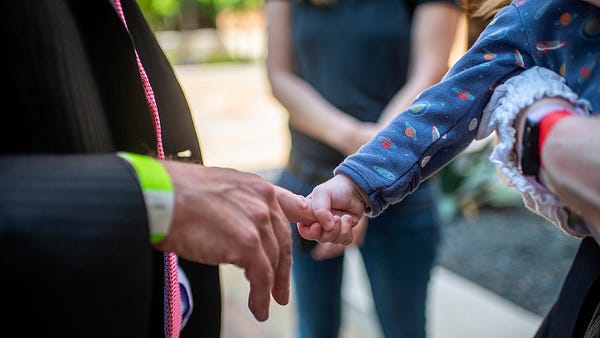
The Free Press

Shilese Jones swung on the uneven bars at the U.S. Olympic Gymnastics Trials a month ago with mesmerizing grace. Her arms extended, her toes pointed, her expression one of total focus, the 22-year-old flung herself backward into the air, pulled her knees in for two flips, then hit the mat in a near-perfect landing. The crowd erupted in cheers.
From afar, it’s hard to see that her left knee is completely covered in tape. Earlier that day in practice, Jones had landed off a vault and immediately clutched her knee with her hand, hopped on one foot, and fell backward, her head hitting the ground. Two coaches picked her up, wrapping her arms around their shoulders, and helped her limp away.
It wasn’t just her knee. Both of Jones’s ankles were fully taped, and she was still nursing a shoulder injury she had sustained at the end of May, at the U.S. Gymnastics Championships. She’d had to withdraw from that competition, admitting the injury was so painful she “barely could raise my arm.”
But here she was, a few weeks later, at the Olympic Trials, winning a higher score on the uneven bars than any of her teammates.
NBC celebrated the fact that she had competed despite her injuries, posting a video on TikTok of her routine, side by side with footage of her mother crying. “A true competitor,” read the caption, followed by a clapping emoji. “After injuring herself in warmups, Shilese Jones competed on uneven bars and her mom had the sweetest reaction.” The NBC commentators can be heard praising Jones’s “grit” and “determination.”
The TikTok video doesn’t show what happened after Jones landed. But I was watching, on television. I saw her walk gingerly off the mat and sit immediately on the ground, stretching her legs out in front of her, and rocking back and forth in what looked like pain. Jones didn’t set foot on the mat again that day. Once perceived as a shoo-in to make the Olympic team, she had to withdraw from the competition, her dreams dashed.
Jones wasn’t the only one to suffer from a serious injury during the two-day competition. Skye Blakely, 19, another favorite to make the Olympic team, ruptured her Achilles tendon and had to be carried away; she left the arena in a wheelchair. Kayla DiCello, 20, fell to the floor after vaulting, then sat on the mat, tears welling in her eyes, and shook her head. She, too, was rolled out of the arena in a wheelchair—another ruptured Achilles.
Of the sixteen women competing that day for five spots on the Olympic team, three left the mat, too injured to get to Paris.
Why are American gymnasts breaking?
Sport is grueling. I know. I grew up as a competitive figure skater. I was on ice before I could fully walk. By the time I was eight or nine, I was in the rink for hours a day. On weekends, I traveled the country for competitions and stints at Olympic training centers. Back home on weeknights, after long practices on the ice, I was in the gym, lifting weights alongside NFL players and other high-performance athletes.
As a kid, each bruise I earned was like a badge of honor, proof of how hard I was working, a symbol of what I was willing to endure to be the best. Every day I took hard falls, and got back up. I thought of myself as resilient. Wasn’t this one of the key lessons sports is supposed to teach us?
Now, though, as I watch the American gymnasts—while reflecting on my own years as a high-performance athlete—I find myself wondering: Is it really okay to push yourself so hard that you can barely walk, all for the sake of sport? And is pain—pain that can be debilitating, pain that can last a lifetime—the price that must be paid for a shot at the Olympics?
Jennifer Sey began training to be a gymnast at the age of five, in the mid-’70s. As a teenager, she tells me, she competed on a broken ankle for years, but “insisted” on carrying on. She was driven—but for her, as for many athletes, there was a blurry line between pushing through pain toward her Olympic dream, and being pushed by someone else’s ambition. Sey says she often ignored her ankle injury at the direction of her coaches, who criticized her for being “weak” if she didn’t “continue to push forward.”
Sey competed with the national team seven times. The public didn’t see the dark side of their lives, she says. The sport was marketed “as sort of shiny little happy pixies dancing around when, you know, we were dancing around on broken ankles.”
In 1985, she fractured her femur at the world championships on the uneven bars, but just one year later, she won the national championships—and then threw herself into training for the 1988 Olympics. But she was starting to break down, “unraveling both physically and emotionally,” she recalls. She developed an eating disorder and experienced suicidal ideation.
“Pain will drive you mad eventually,” she says.
At the age of 19, she stopped competing nationally, citing her ankle injury, and went to college. But she says the culture of USA Gymnastics only got worse after she left.
In 1988, the Olympic team got a new coach, Bela Karolyi, who had coached the great Romanian gymnast Nadia Comaneci before defecting to the U.S.; eight years later, his wife Marta joined him as an Olympic coach. Theirs became a household name, as every U.S. Olympic team the Karolyis oversaw won a medal; in 2000, the couple were inducted into the USA Gymnastics Hall of Fame, which still describes them as “the most successful women’s national and international gymnastic coaches in the history of America.”
But behind the scenes, they ran a grueling training gym in Texas, a place known as the Ranch, perpetuating the harshest forms of abuse in sport. Athletes have alleged the Karolyis restricted their food, physically hit them, denied them medical treatment, and maintained a culture of fear. Many were subjected to sexual abuse by their team doctor, Larry Nassar, who is now serving 40 to 175 years in prison for assaulting over 500 victims. The Karolyis have denied knowledge of Nassar’s abuse.
Sey says that the Karolyis weren’t the first coaches to mistreat athletes, but, she argues, “they made it aspirational.”
“This approach of intense cruelty toward athletes” became the norm, Sey tells The Free Press, “because Team USA started winning.”
The Karolyi era can be encapsulated by a single moment. At the 1996 Olympics, the U.S. women’s team was on the cusp of a gold medal. All Kerri Strug, an 18-year-old from Arizona, had to do was land her vault in one of two tries. But she came down slightly angled on the first attempt, slipping back with her legs extended. Something was wrong with her ankle.
She reportedly “couldn’t feel her left leg,” but Bela said to her, “we need you to go one more time,” to win the gold.
So Strug limped back to the starting position for a second try. She sprinted to the vault, threw herself over it and landed near-perfectly—then almost immediately pulled up her left foot and dropped to the mat, grimacing in pain.
Team USA had won.
Strug became an American hero that day. There are pictures of Bill Clinton, a foot and a half taller, beaming down at her. She was on the cover of Sports Illustrated. Completing the vault when she was in such pain became part of her legend.
How did Sey feel about the reaction? She found it “disgusting.” Watching Strug vault when she could barely walk “enraged” her.
“She didn’t have a choice,” Sey says. “It is a culture of total obedience. You don’t have a vote in your own well-being.”
Strug would never compete again. Marta Karolyi remained the national team coordinator until 2016.
The dark side of USA Gymnastics has only come to light in the last decade. In 2016, the Indianapolis Star first exposed allegations of sexual abuse against Nassar. Those investigations led to further stories, detailing how the sport’s top executives ignored repeated allegations of not just sexual abuse but physical and emotional abuse as well. More and more athletes came forward to describe what they had suffered—including at the hands of the Karolyis.
Since then, the sport has been in crisis mode. In 2017, a body called SafeSport was established, to investigate allegations of abuse in youth sports. In 2023, the center received over 7,500 reports. However, SafeSport is widely thought to be slow and ineffective.
In the meantime, USA Gymnastics has aggressively rebranded. In 2018, the organization officially cut ties with the Karolyis. And in a 2021 report, it claimed it was “an entirely new organization,” with nearly 60 percent of current staff hired in 2017 or later, and an entirely new board of directors. It now claims it “prioritizes athlete safety and wellness.
From a publicity perspective, the rebrand worked. USA Gymnastics regained sponsorships previously lost. Meanwhile, Simone Biles has given the sport star power it hasn’t had in years. Lauded as one of the greatest gymnasts of all time, Biles made history in a different way at the 2020 Tokyo Olympics, held in 2021 due to Covid, when she withdrew from the competition—not because she was physically injured, but because she felt mentally unwell. Under immense pressure to excel, Biles messed up a vault. She’s since described what she felt, up in the air: “I have no idea where I am.”
“I thought I was gonna be banned from America,” she says, “because that’s what they tell you: Don’t come back if it’s not gold.”
Some reacted harshly to her decision to step away, especially on social media, but in the main it was celebrated as a turning point in the sport—a sign that athletes finally had permission to speak up for themselves and prioritize their own well-being over the pursuit of medals.
“Finally,” Sey recalls thinking, “an athlete made a decision in defense of her own well-being.”
“It was like an 8.0 on the gymnastics earthquake Richter scale,” Robert Andrews, Biles’s former sports therapist, tells me. “It was an epic event in this sport.”
Now, Andrews feels that gymnastics has since changed for the better: “When you watch the meets now, the girls are laughing. They’re hugging each other. The coaches are hugging them. They’re high-fiving. That part of it is wonderful, because gymnastics can be fun for them. I don’t think it was very fun for girls in the Karolyi era.”
Three years after Tokyo, Biles is back in the Olympics, once again at the top of her game. Three of her teammates will be watching from afar. The New York Times has attributed the “rash of injuries” sustained at the trials to the “anxiety” that accompanies a big competition. Thanks to Biles, there’s more awareness about athletes’ mental health. But where she was praised for dropping out in 2020, Shilese Jones was celebrated just a few weeks ago for competing despite the risk to her physical health.
The good news is there’s no evidence any of the three injured women have been subjected to Karolyi-style abuse. But when I imagine a world where abuse is completely eradicated in sport, I still wonder if injuries will always be inevitable. I was lucky: I never trained in an environment that was anything but supportive, but I still pushed myself to the limit. When I was around nine, I went up for a jump at a training camp in Minnesota, and when I came back down, my left skate got stuck in the ice and my shin bone nearly cracked in half.
As a spectator, it can be hard to understand why an athlete like Shilese Jones would get back on the bars after suffering more injuries than she can count. Or why Simone Biles would come back after the pressure of the last Olympics. But as an ex-athlete, I get it. I spent months with a cast all the way up to my hip, bound to an air mattress in my living room because I couldn’t get up any stairs in my house. And yet, despite all that pain, all I wanted to do was get back on the ice. When I did, I was terrified.
At some point, I realized I was never going to be good enough to make the Olympics. But my time competing taught me that when sport takes over your life—when the Olympic rings are even a small, distant, improbable goal—it becomes who you are.
“They push, they push, and they push, because they want that Olympic dream,” Andrews, Biles’s former therapist, tells me. “There’s a certain level of pain that goes with gymnastics.”
“It’s a very dangerous sport,” says Sey, who has a hard time watching gymnastics these days.
It makes me uneasy to watch these women, too. I understand why they would do everything within their power, and sometimes beyond it, to achieve a dream they’ve had since they were little girls. But I’m also left wondering: If USA Gymnastics is really trying to protect these athletes, do they also need to protect them from themselves? Where, after all, is the line that separates “grit” from self-harm?
Francesca Block is a reporter for The Free Press. Follow her on X @FrancescaABlock.
To support our work, become a Free Press subscriber today:

















From a medical perspective, I see, potentially, several factors that are likely contributors to what seems to me to be an overall increase in sports injuries. Year-round training and participation in a single sport does not allow for an off-season for minor chronic muscle strains and ligament sprains from ever completely healing, or the use and development of other groups of muscles that can complement those most necessary for the sport in question. I have a theory that the common and frequent use of non-steroidal anti-inflammatory drugs, e.g. ibuprofen, naproxen, contributes in at least two ways--it blocks some of the pain feedback that limits what we are willing to put our bodies through, and it blocks some of the necessary inflammation involved in the process of healthy healing of injured tissue--both leading to chronic weakening of the involved muscles, ligaments, and joint surfaces. Heavier average body weight may be attributed simply to increased muscle mass, but there is a law of diminishing returns when this added mass puts added stress on joint supporting tissues as well as the skeletal system--the bony tissue itself. Think of the muscle mass of a Sherpa guide in the Himalayas. They are incredibly strong and have off-the-charts conditioning and stamina, but they are quite slender by Western standards. Muscles don't have to be bigger to be stronger and better conditioned. And then the never-ending mission to break previous records, records that may already represent the outer limits of a strong, healthy, outlier type of human body, leads not only to pushing through the pain to achieve "mind over matter", but beyond the limits of that matter. We do not all have the same limits (sorry, equity of outcome disciples), but we all have limits.
Why is nothing mentioned about the parents in these situations? I'm sure it's hard for them when their child shows extraordinary talent and determination at a young age. But come on, can parents be held accountable for their passive part in their child's well being? Could it be that some are, at best, turning a blind eye, and at worst, the ones actually pushing their kids to their limit? I'd like to read a well-researched article about the parents behind these athletes.